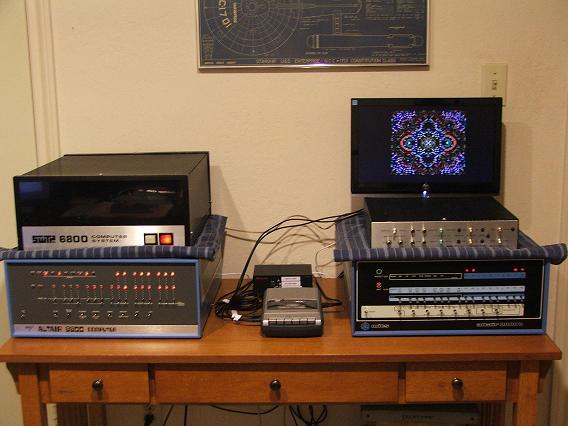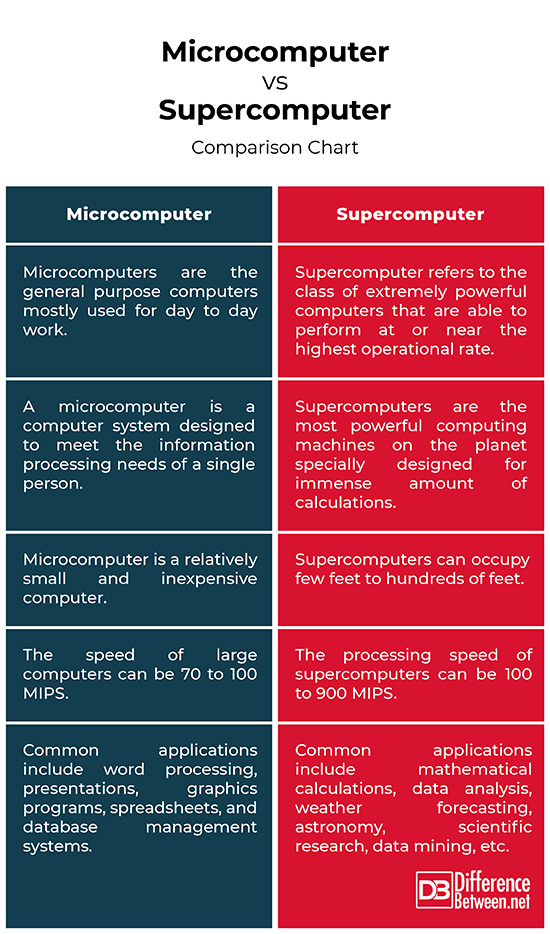Difference Between Microcomputer and Supercomputer
Ask any average person what are the different types of computers he or she knows about and the answer will probably be, ‘Dell, HP, IBM…’However, these are merely the brands of the computers. The computers (roughly in order of size and speed) are categorized as: microcomputers, minicomputers, mainframes, and supercomputers. Microcomputers are designed for use by a single use and are commonly known by the PC. Mainframe computers are used by large organizations for large information processing jobs. Minicomputers fall somewhere between the mainframe computers and microcomputers. And supercomputers are the most powerful computing machines on the planet designed to solve complex problems quickly and easily. We’ll be discussing about microcomputers and supercomputers in detail and try to understand the difference between the two in terms of speed, size, computing power and functionality.
What is a Microcomputer?
Microcomputer is a relatively small and inexpensive computer that contains a microprocessor as its central processing unit (CPU). Microcomputers are commonly known by their more familiar name – the PC. This is the type of computers that you are most likely to use as personal computers. Designed for single use, microcomputers are much smaller than other forms of computers and the CPU of which is contained on a single integrated circuit. It is a computer system designed to meet a single user’s information processing needs. Portable computers, such as laptops and handheld computers are also called microcomputers. The CPU consists of the Control Unit (CU), the Arithmetic/Logic Unit (ALU), and RAM. The common applications of microcomputers in workspace include data and word processing, electronic spreadsheets, and database management systems.
What is a Supercomputer?
Supercomputer refers to the class of extremely powerful computers that are able to perform at or near the highest operational rate. It is a general term given to the fastest computer in the world. These types of computers are very large and may take up several rooms. They are used to solve complex problems, including the simulation and modeling of physical phenomena such as climate change and the behavior of molecules; data analysis such as genome sequencing and astronomical observations. Supercomputers are known for their unparalleled processing capabilities and are capable of processing trillions of instructions per second. Because of that, supercomputers are used for large amounts of complex mathematical calculations, such as simulating and nuclear research. Previously, supercomputers were used to handle large databases for scientific and engineering applications. Today, they are the most powerful computing machines on the planet specially designed for immense amount of calculations.
Difference between Microcomputer and Supercomputer
Size
– Microcomputers are the general purpose computers mostly used for day to day work. A microcomputer is a relatively small and inexpensive computer that contains a microprocessor as its central processing unit (CPU). It’s a complete computer on a small scale, designed for use by single person at a time. Supercomputers, on the other hand, are the most powerful computers on the planet and are very large and may take several rooms. A powerful supercomputer can fill a server room the size of two tennis courts. Supercomputers can occupy few feet to hundreds of feet.
Speed
– Microcomputers are commonly known by their more familiar name – the PC. This is the type of computers that you are most likely to use as personal computers. The processing speed of microcomputers is less than minicomputers and mainframes. The speed of large computers can be 70 to 100 MIPS. Supercomputers, on the other hand, are a class of extremely powerful computers that are able to perform at or near the highest operational rate. The processing speed of supercomputers can be 100 to 900 MIPS. In fact, supercomputers are the most powerful computing machines on the planet.
Applications
– Microcomputers are commonly used in workplace for a wide variety of applications such as data and word processing, presentations, graphics programs, spreadsheets, and database management systems. The term microcomputer is commonly referred to what we primarily know as the “personal computer.” Portable computers, such as laptops and handheld computers are also microcomputers. Supercomputers are the undisputed leaders of the computer world, specially designed to solve complex problems, including the simulation and modeling of physical phenomena such as climate change and the behavior of molecules; data analysis such as genome sequencing and astronomical observations.
Microcomputer vs. Supercomputer: Comparison Chart
Summary
Microcomputers are the type of computers that you are most likely to use as personal computers. This type of computers is relatively small and inexpensive, and is designed to meet the information processing needs of a single user. And they are much smaller than other forms of computers and the CPU of which is contained on a single integrated circuit. Supercomputers, on the other hand, are a class of extremely powerful computers that are able to perform at or near the highest operational rate. Supercomputers, thanks to their exceptional processing power, are used in the fields that require vast amounts of complex mathematical calculations. They are the most powerful computing machines on the planet specially designed for immense amount of calculations.
- Difference Between Caucus and Primary - June 18, 2024
- Difference Between PPO and POS - May 30, 2024
- Difference Between RFID and NFC - May 28, 2024
Search DifferenceBetween.net :
Leave a Response
References :
[0]Image credit: https://commons.wikimedia.org/wiki/File:Microcomputer_Collection.jpg
[1]Image credit: https://commons.wikimedia.org/wiki/File:Sierra_Supercomputer_(48002385338).jpg
[2]Skeete, Kelvin. CXC Information Technology. Cambridge, United Kingdom: Cambridge University Press, 2004. Print
[3]Kent, Allen and James G. Williams. Encyclopedia of Microcomputers (Volume 17). Boca Raton, Florida: CRC Press, 1995. Print
[4]Burd, Stephen D. Systems Architecture. Boston, Massachusetts: Cengage, 2010. Print



